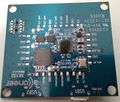Radar Velocity
This page will be dedicated to a radar velocity sensor.
27th January 2020
We have ordered some radar sensors from Acconneer, namely the A111, in the XM132, and XE132. And some radar lenses for these.
The XE132 from acconeer comes with pre-compiled binary software, that allow it to connect via micro USB to a computer and create visualizations of the data.
The XE132 was set up as per the user guide, as was the Acconneer portable exploration tool.
Of interest to our application is the sparse short-time FFT visualisation as it allows the speed to be determined at different distances from the sensor. As can be seen from the gallery there is an FFT for each of the 6cm distant ranges, a matrix plot of the velocity-speed readout of the sensor.
Open question which need to be answered for this sensor are of question of how the lens impacts performance, if the Doppler shift of water can be measured, and at what angle to the flow is the Doppler shift successfully measured.
28th January 2020
Today we will test the XE132 in the flume. Just a basic test will be conducted. The radar sensor will be pointed at the flume surface and the short time fft visualization tool will be used to detect if a Doppler shift if present. Different angles and lens configurations will be tested.
It was found that the water velocity was not able to be easily seen with the acconneer radar sensor. It seem that the issue being had is that there is little reflection off the water surface. A wide range of angles were tested. Specifically the velocity was not seen to go above about 0.1 m/s. This was not easily separable from errors such as the water surface level changes.
Following some more tests in the flume it was seen that the high velocity readouts occurred when the water velocity was greatest, hence adding to the hypothesis that the changes in surface height were being measured more than the water velocity itself.
In another test outside the flume, the radar sensor was moved at an angle to the floor and at a constant height. At a 45 degree angle it was seen that the Doppler shift was able to be measured, however with a weak signal, as the angle decreases this signal became stronger in amplitude but the measured velocity decreased until when the radar was pointed vertically, no horizontal movement would cause Doppler shift. This test highlights that a good reflected signal occurs perpendicular to the surface, but a good Doppler shift occurs parallel to the surface.
If this system is going to function, it is needed to test how to achieve a better reflection of water and how to minimise the effect of water surface changes.
In investigating other high cost Doppler radar sensors, they all seem to require a minimum surface ripple height of about 3mm. I have a suspicion that this is because the reflect the Doppler signal off the rising slope of the wave, hence getting a good reflection angle to bounce the signal back to the sensor. These sensors are also quoted as measuring the surface velocity, which further supports this. https://www.mdpi.com/2072-4292/12/8/1296/htm discusses this listing the small surface waves as scatterers. That paper also predicts the optimal size for a 60GHz surface scatterer wave is 3mm. In reflecting on the flume experiment, it the flow was very smooth at some parts, the lack of reading is not explained with the above information.


